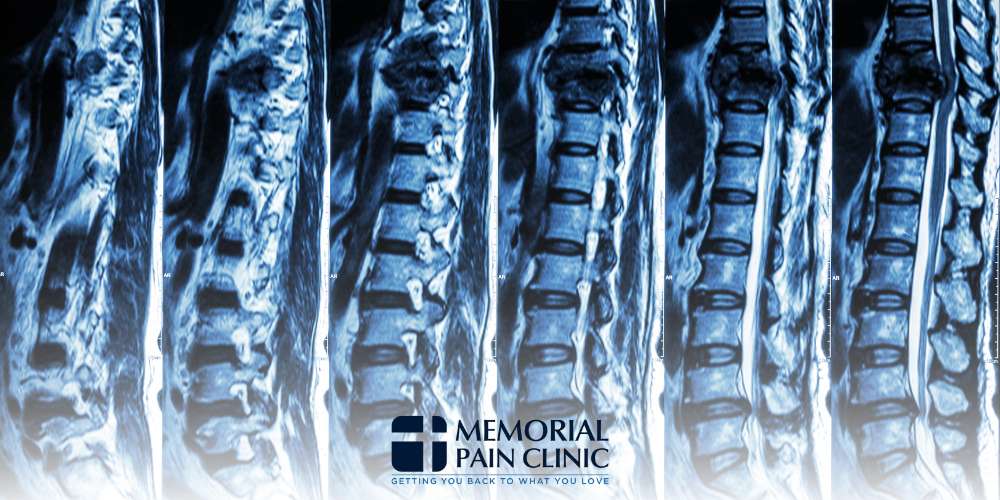Kyphoplasty Tulsa, OK
Our Services

Kyphoplasty Procedure in Tulsa for Vertebral Pain Relief
If you’re seeking relief from the debilitating effects of vertebral compression fractures, Memorial Pain Clinic in Tulsa, OK, offers advanced solutions like kyphoplasty. Our team of experienced pain management specialists understands the challenges associated with spinal fractures, and we’re committed to providing personalized care tailored to your unique needs.
Kyphoplasty is a minimally invasive procedure designed to stabilize a vertebral fracture, alleviate pain, and restore spinal function, allowing you to regain mobility and improve your quality of life. Call (918) 200-9944 and discover how kyphoplasty at Memorial Pain Clinic can help you find pain relief and reclaim your independence.
What Is Kyphoplasty Surgery?
Kyphoplasty surgery is a minimally invasive procedure used to treat vertebral compression fractures, often caused by osteoporosis or trauma. Patients may receive local or general anesthesia prior to the procedure. During the procedure, a small incision is made, and a balloon-like device is inserted into the fractured vertebra.
The balloon is then inflated to create space within the bone, which is subsequently filled with bone cement to stabilize the vertebra and restore its height. This not only alleviates pain but also helps improve spinal alignment and function, allowing patients to regain mobility and resume their daily activities with reduced discomfort.
Balloon Kyphoplasty for Vertebral Compression Fractures
The balloon used in a kyphoplasty procedure creates space within the fractured vertebral body. Inflating the balloon gently elevates the collapsed portion of the bone, restoring its height and creating a void where bone cement can be injected. This helps stabilize the fractured bone, alleviate pain, and restore spinal alignment
Thoracic Kyphoplasty
Kyphoplasty can be performed in the thoracic region of the spine to treat a vertebral compression fracture. The thoracic spine is the middle portion of the spine, which consists of twelve vertebrae between the cervical and lumbar regions.
Vertebroplasty vs Kyphoplasty
Vertebroplasty and kyphoplasty are both minimally invasive procedures used to treat vertebral compression fractures, but they differ in technique and purpose. Vertebroplasty involves the injection of bone cement directly into the fractured vertebra to stabilize it and alleviate pain. In contrast, kyphoplasty utilizes a balloon-like device to create space within the fractured vertebra before injecting the bone cement.
This additional step of inflating the balloon helps restore vertebral height, correct spinal deformities, and potentially reduce the amount of cement needed. Consequently, kyphoplasty may offer benefits such as improved vertebral alignment and reduced risk of cement leakage compared to vertebroplasty.
What Is the Kyphoplasty Success Rate?

Kyphoplasty has a very high success rate as a treatment for vertebral compression fractures. Many studies show that this minimally invasive procedure has a success rate of 90% or higher. This means that 90% of patients had partial or full pain relief after the procedure.
What Are the Side Effects of Kyphoplasty?
Like any procedure, kyphoplasty has potential side effects. It is generally considered a safe solution for spinal compression fractures, but it’s important for patients to understand potential complications before undergoing the procedure. Complications are rare, but can include the following.
- Discomfort or soreness at the incision site
- Bruising
- Minor bleeding
- Temporary increase in back pain after the procedure
- Rarely, damage to spinal nerves or spinal cord, allergic reaction, or leaking of bone cement
Is Kyphoplasty Safe for Elderly Patients?
Kyphoplasty can be a safe and effective treatment option for elderly patients who are experiencing painful vertebral compression fractures, particularly those caused by osteoporosis. It’s important to have an experienced kyphoplasty surgeon repair vertebral compression fractures. Experience and a thorough patient evaluation go a long way when it comes to increasing the likelihood of a successful outcome.
How Long Does Kyphoplasty Last?
The procedure itself takes around a half hour for each fractured vertebra treated. The results of kyphoplasty, however, can last as long as three years, according to one study. It is a popular option for patients who experience back pain but are hesitant to undergo invasive spinal surgery.
Is Kyphoplasty Permanent?
For some patients, kyphoplasty used to treat compression fractures can have permanent pain relief benefits. Other patients may require additional treatments for their pain after the effects of their kyphoplasty procedure have worn off.
What Is the Kyphoplasty Recovery Time?
Many individuals are able to resume light activities within a few days to a week after the procedure. It can be performed in a hospital or outpatient clinic, and patients usually go home the same day as the procedure. However, we typically recommend avoiding heavy lifting, strenuous activity, and bending or twisting of the spine for several weeks to allow the treated vertebrae to heal properly.
The recovery time after kyphoplasty can vary from person to person, but most patients typically experience relief from their symptoms relatively quickly. It’s important for patients to follow their healthcare provider’s instructions carefully and attend any recommended follow-up appointments to monitor their progress and ensure optimal healing.
Long-Term Restrictions After Kyphoplasty
Your doctor will inform you of any permanent restrictions after the procedure. You should be able to return to your usual activities after you have fully recovered, but we strongly recommend speaking with your doctor about how to safely return to your daily routines.
Some common restrictions for protecting your spinal vertebrae after kyphoplasty include the following.
- Avoid driving for at least 24 hours after the procedure.
- Do not lift anything heavy enough to strain your back for at least 24 hours.
- Refrain from heavy lifting or strenuous exercise for four to six weeks.
- Take your medications as directed by your provider.
If you struggle with pain after the procedure, ask your doctor about what pain medicine is safe to take and how soon you can take it.
How Long After Kyphoplasty Can You Bend Over?
Avoid bending over until your doctor advises you that it is safe to do so. Due to the nature of the procedure, it is extremely important to take care of your spine during recovery. You may be expected to avoid bending or twisting movements for a few weeks or more. If your doctor recommends physical therapy, your physical therapist will help you take care of your spine while building strength and regaining movement.
Contact the Kyphoplasty Surgeons in Tulsa at Memorial Pain Clinic

At Memorial Pain Clinic in Tulsa, OK, we are dedicated to helping you find relief from the debilitating pain of vertebral compression fractures through advanced treatments like kyphoplasty. Our compassionate and experienced team is committed to providing personalized care tailored to your specific needs, ensuring you receive the best possible outcome.
If you are struggling with spinal fractures and seeking a solution that can restore your mobility and improve your quality of life, contact Memorial Pain Clinic today to schedule a consultation. Let us help you take the first step towards a pain-free future with our expert kyphoplasty services.

